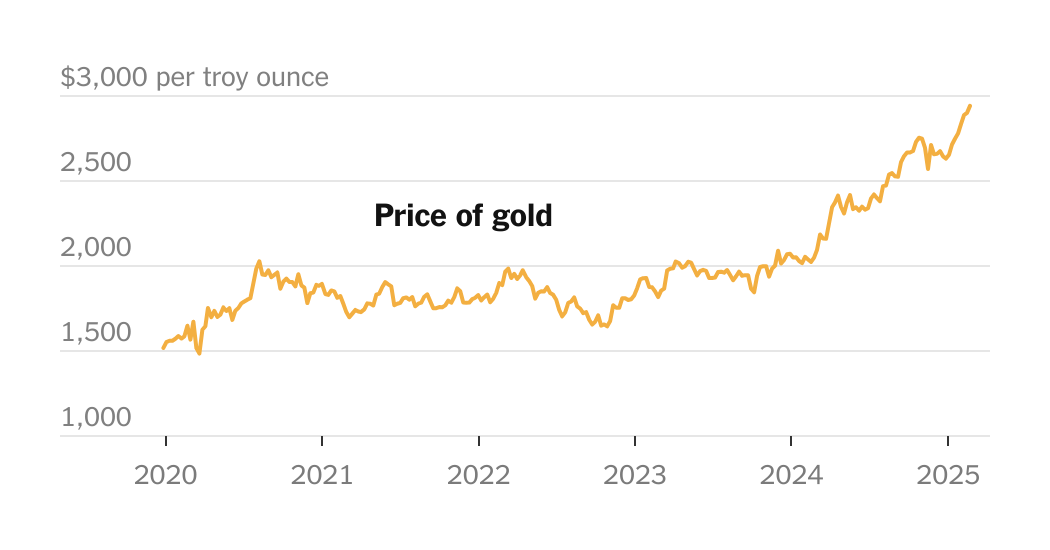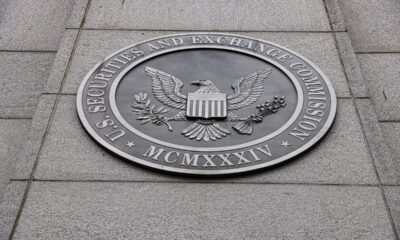Breaking News
Why the Price of Gold Keeps Going Up

President Trump declared the start of a “golden age” at his inauguration, and the price of gold has indeed been soaring. Trading at over $2,900 per troy ounce, gold has seen a 12% increase this year following a 27% gain last year. Analysts are optimistic about its future performance, with many upgrading their forecasts.
The demand for gold in New York, the global hub for futures trading, has caused delays in getting bars out of London vaults, where the physical gold market is based. Even Mr. Trump has expressed interest in verifying the gold reserves at Fort Knox, highlighting the precious metal’s significance in today’s economy.
Despite traditionally being a safe haven asset, gold’s recent surge is attributed to fears surrounding Trump’s policies on tariffs and deportations, which could lead to increased inflation and geopolitical tensions. Investors are turning to gold as a hedge against market volatility and uncertainty.
The rise in gold prices since the election of Donald Trump has been driven by a search for uncorrelated assets. While gold may not be perfect for this purpose, its appeal as an insurance asset has driven up demand and prices.
Trade war looming? Buy gold.
The threat of reciprocal tariffs by Trump could spark a trade war, making gold the best performing asset according to global fund managers surveyed by Bank of America. In times of economic uncertainty, gold tends to shine as a safe investment.
Tariffs and geopolitical tensions have fueled the demand for gold, playing to its strengths as a reliable asset during times of economic turmoil. Stockpiling of gold in the U.S. due to fears of direct tariffs on gold imports has led to a significant increase in gold inventory.
UBS has raised its forecast for the price of gold, predicting it will reach $3,000 per ounce by the end of the year due to concerns over tariffs and their impact on the global economy.
Trans-Atlantic demand imbalance? Buy gold.
The widening gap in gold prices between New York and London, driven by fears of potential tariffs, has led to an influx of gold shipments to New York. However, the process of moving gold is slow and costly due to its weight and security requirements.
Central bank demand for gold has been a major driver of the recent price surge, with countries like Poland increasing their gold reserves to diversify away from the dollar. The geopolitical landscape has also played a role, with fears of financial sanctions prompting central banks to stock up on gold.
The current surge in gold prices is driven by a combination of factors, including central bank buying, geopolitical tensions, and fears of economic instability. As investors seek safe havens, gold continues to be a popular choice for protecting wealth in uncertain times.
-

 Destination8 months ago
Destination8 months agoSingapore Airlines CEO set to join board of Air India, BA News, BA
-

 Breaking News10 months ago
Breaking News10 months agoCroatia to reintroduce compulsory military draft as regional tensions soar
-

 Tech News12 months ago
Tech News12 months agoBangladeshi police agents accused of selling citizens’ personal information on Telegram
-

 Gadgets3 months ago
Gadgets3 months agoSupernatural Season 16 Revival News, Cast, Plot and Release Date
-

 Productivity11 months ago
Productivity11 months agoHow Your Contact Center Can Become A Customer Engagement Center
-

 Gadgets3 weeks ago
Gadgets3 weeks agoFallout Season 2 Potential Release Date, Cast, Plot and News
-

 Breaking News10 months ago
Breaking News10 months agoBangladesh crisis: Refaat Ahmed sworn in as Bangladesh’s new chief justice
-

 Toys12 months ago
Toys12 months ago15 of the Best Trike & Tricycles Mums Recommend























